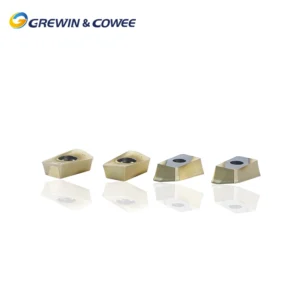Inhaltsverzeichnis
UmschaltenTurning Inserts
When it comes to machining titanium, selecting the right turning inserts is crucial for achieving efficiency, precision, and cost-effectiveness. Titanium, known for its high strength-to-weight ratio and corrosion resistance, presents unique challenges that require careful consideration of the tools and methods used. Ultimately, the choice of Dreheinsätze for titanium can significantly impact the quality of the final product and the overall machining process.
Understanding Titanium and Its Challenges
Before delving into the specifics of turning inserts, it is essential to understand why titanium is challenging to machine. Titanium is tougher than many other metals, displaying a strong tendency to work-hardening. This means the material can become harder with continued cutting or deformation, leading to more wear on tools. Additionally, titanium has a low thermal conductivity, which can cause the cutting edge of the tool to overheat if not managed properly. This is where selecting the right turning inserts for titanium becomes imperative.
Key Factors in Selecting Turning Inserts for Titanium
Insert Material
The material of the turning inserts plays a significant role in determining how well they will perform when machining titanium. Common materials for turning inserts include carbide, ceramic, and CBN (Cubic Boron Nitride). For titanium, carbide inserts with a special coating are often recommended due to their excellent hardness and heat resistance. For example, a carbide insert coated with titanium nitride (TiN) can help improve tool life by reducing friction and heat during the machining process.
Geometry and Design
The geometry of turning inserts significantly influences performance. Inserts with a sharp edge and a positive rake angle can help reduce cutting forces and improve chip removal. This is particularly important when working with titanium because a well-designed insert will allow for smoother cutting, reducing the risk of work-hardening. For instance, an insert designed with a larger clearance angle can help minimize contact with the material, further reducing the effort needed to cut through titanium.
Cutting Conditions
Understanding the specific cutting conditions, such as feed rate and depth of cut, is crucial when selecting turning inserts for titanium. A higher feed rate can be beneficial to quickly remove material, but if too high, it could lead to insert wear and poor surface finish. Consequently, finding the right balance is essential. For example, if you are machining large components, you might consider heavier inserts that can withstand higher loads, while for smaller components, lighter inserts may be sufficient.
Coatings and Treatments
The coatings and treatments on turning inserts can enhance their performance when machining titanium. Coatings such as TiAlN (Titanium Aluminum Nitride) can offer superior abrasion resistance and thermal stability, extending the life of the insert. As such, evaluating the coating technology and its compatibility with titanium machining should be a priority. For example, some manufacturers offer inserts with multiple layers of coatings designed to withstand extreme temperatures, making them ideal for the demanding environment of titanium machining.
Application Areas for Turning Inserts in Titanium
Turning inserts for titanium are broadly used across various industries, highlighting their versatility. The aerospace sector, for instance, relies heavily on titanium components due to their lightweight yet strong properties. Here, precision is paramount; turning inserts need to maintain tight tolerances while reducing scrap and ensuring the highest level of surface finish.
Another area of application is the medical industry, where titanium is used for implants and surgical instruments. The biocompatibility of titanium makes it a preferred choice, but the machining processes are equally important to ensure quality and precision. The right turning inserts can facilitate achieving the fine tolerances needed for such applications.
In the automotive sector, particularly in high-performance vehicles, titanium parts are often utilized for weight reduction. The use of effective turning inserts can streamline the production process, allowing for faster machining while maintaining quality.
Evaluating Performance and Costs
When selecting turning inserts for titanium, it’s equally important to consider performance against cost. While it might be tempting to seek the cheapest option, investing in high-quality turning inserts can yield better long-term savings. For instance, a more expensive carbide insert with superior wear resistance may not only last longer but also reduce downtime related to tool changes, thereby enhancing overall productivity.
To illustrate, a manufacturer decided to invest in high-quality turning inserts for titanium machining. Initially hesitant about the cost, they later found that the extended tool life significantly reduced the amount spent on replacements. Additionally, the superior surface finish produced by these inserts reduced subsequent finishing processes, ultimately saving time and costs.
Fazit: Die richtige Wahl treffen
Choosing the best turning inserts for titanium machining is not a simple task; it requires a thorough understanding of the material, the specific application, and the various factors mentioned above. By considering insert material, geometry, cutting conditions, and coatings, machinists can select turning inserts that will not only enhance efficiency but also ensure high-quality outcomes.
Given the unique machining challenges presented by titanium, investing in the right turning inserts is key to achieving both operational success and product excellence. Whether in aerospace, medical, or automotive applications, understanding the needs of your specific project will guide you in making the best choice. As you seek to enhance your machining processes, remember that the right turning inserts for titanium can make all the difference in productivity, cost efficiency, and the overall quality of your final products.

